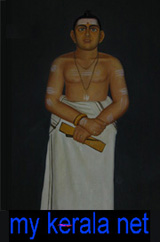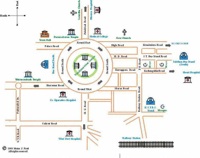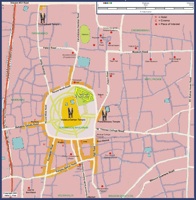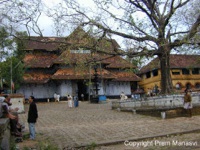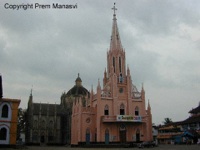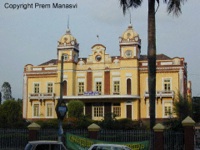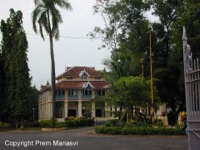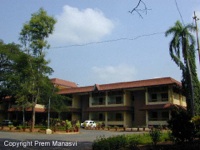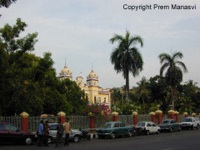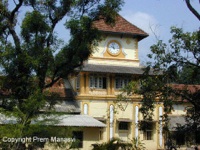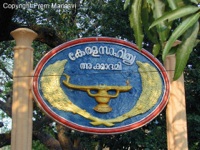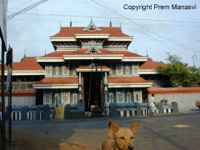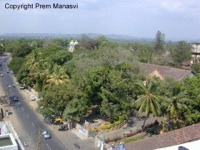Click to Enlarge !
- Einführung
- Glossar
Trichur / Thrissur / Trissur - die kulturelle Hauptstadt von Kerala
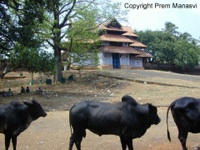 Trichur (10032'nördlicher Breitengrad und 76015' östlicher Längengrad), die Kreisstadt des gleichnamiges Landkreises, versteht sich als die kulturelle Hauptstadt von Kerala.
Trichur (10032'nördlicher Breitengrad und 76015' östlicher Längengrad), die Kreisstadt des gleichnamiges Landkreises, versteht sich als die kulturelle Hauptstadt von Kerala.
Trichur liegt ungefähr in der Mitte des Bundesstaates Kerala und ist aufgrund eines gut vernetztes Straßen- und Schienensystem, dem nahegelegenen Internationalen Nedumbassery Flughafen Kochi (Cochin, Ernakulam)and dem Seehafen Kochi national und
internationalleicht erreichbar.
Die Stadt ist auf einem ansteigenden Gelände gebaut, auf dessen Anhöhe sich die älteste und größte Tempelanlage des Landes befindet, die seit dem 8 Jhd. AD berühmte Vadakunnathan Tempelanlage. Die sie umgebende mächtige hohe Mauer mit ihren wuchtigen mehrstöckig gestalteten Torbauten auf allen vier Seiten bildet den wunderbaren Hintergrund für den Prunk des berühmten Trichur Puramfests, das jedes Jahr in der
Zeit zwischen März und April stattfindet. Außerhalb der Tempelmauer ist ein freies Gelände, das einst mit einenm dichten Teakholzbaumwald bedeckt war und deshalb Tekkinkadu (Teakholzbaumwald) genannt wird. Die Gesamtfläche dieser Anlage einschließlich dem offenen Gelände misst ungefähr 3.6 Hektar und wird umkreist von einer breiten Ringstraße, von wo aus sich sternförmig die Landstraßen in alle Richtungen ausbreiten.
Der Tempel hat drei Allerheiligste, die Lord Shiva in der Gestalt von Vadakunathan, Sri Sankaranarayanan und Sri Rama gewidmet sind und nach der Legende von Parasurama installiert wurden. Die Wände des Tempels sind mit Gemälden und Skulpturen geschmückt..
Karten
Glossary
| Namboodiri | name of the brahmin caste in Kerala |
| Brahmin | the caste of the priest; the highest caste in the Hindu society |
| Malayalam | the regional language of Kerala |
| thattakam | people of the localities where the temples are located |
| pooram | 'the meeting point of all the arts', a temple festival |
| nettipattam | frontlet of the elephant = a large piece of cloth with thousands of gold plates stitched together sp closely making it appeal as if they are part of the elephant’s forehead |
| thidambu | replica of the idol |
| venchamaram | yak tail fans |
| alavattom | peacock feathered circular fans |
| parasol | long stemmed shimmering and glittering ceremonial umbrellas ceremonial umbrellas made out of silk and satin laced with white metal |
| kudamattam | exchange at incredible speed of parasols, thread by Brahmin priests in ‘dhoties’, flanked by two others standing with the venchamaram and alavattomaloft the backs of the tuskers |
| koodikazhcha | face-to-face procession (the 'kudamattam' along with the 'koodikazcha' are also known as the divine bazaar |
| vedikkettu | fireworks |
| melam | combined drumming |
| pandi melam | an orchestra of four instruments – the Chenda, the Kuzhal, the Kombu and the Ilathalam, played mainly in the major temple festivals of Kerala like the Thrissur Pooram. |
| chenda melam | percussion event, featuring the Chenda |
| panchavadyam | a percussion ensemble , typical of Kerala, consisting of ‘pancha’ (five) (pancha) ‘vadyam’ (instruments): ‘maddalam’, ‘edakka’, ‘thimila’, ‘ilathalam’ and ‘kombu’. |
| chenda | a double-headed drum made of soft wood with both ends covered with cowhide. The musical notes of this instrument are adjusted by strings and small bamboo rings. The Chenda is played either with one hand and a stick or with two sticks beating the upper end while being kept in a vertical position by a strap over the player's left shoulder. Deft use of the palms can produce four different tones. It is the chief accompaniment in Kathakali (the classical dance-drama of Kerala) and the most important percussion instrument played during temple festivals. |
| edakka | an extremely sensitive percussion instrument. Made of wood and about a quarter meter long, the drumheads are held in position by interlacing cotton threads. The player beats the drum with one hand while simultaneously manipulating the strings with the other, thus creating a variety of musical notes. |
| ilathalam | a native version of the cymbals |
| kombu | a horn (kombu). It is a C-shaped wind instrument made of brass or copper. Its shrill blare helps in subduing the pitch of the other instruments |
| maddalam | known since the 13th century - is considered to be a ‘deva’ (divine) ‘vadya’ (instrument), included as a major accompaniment in the 'Dance of Lord Siva, the Destroyer'. There are two varieties: Suddha maddalam and Toppi maddalam. The former is tied around the waist of the player with a cloth, while the latter is a smaller version suspended from the neck of the player. Barrel shaped and carved from jack wood, both ends of the maddalam are covered with stretched hide and fastened by leather straps. It is also an important instrument in art forms like the Kathakali, Krishnanattom and Tullal |
| thimila | an hour-glass shaped drum made from polished jackwood. The drumheads made of calf hide are held together by leather braces which are also twined round the waist of the drum. This mechanism helps in adjusting the tension and controlling the sound. It is a must during temple rituals like Seeveli, a ceremonial procession of deities. |
| devi | goddess |
| sastha | divine combination of Shiva and Vishnu |
| paradevatha | family deityv |
